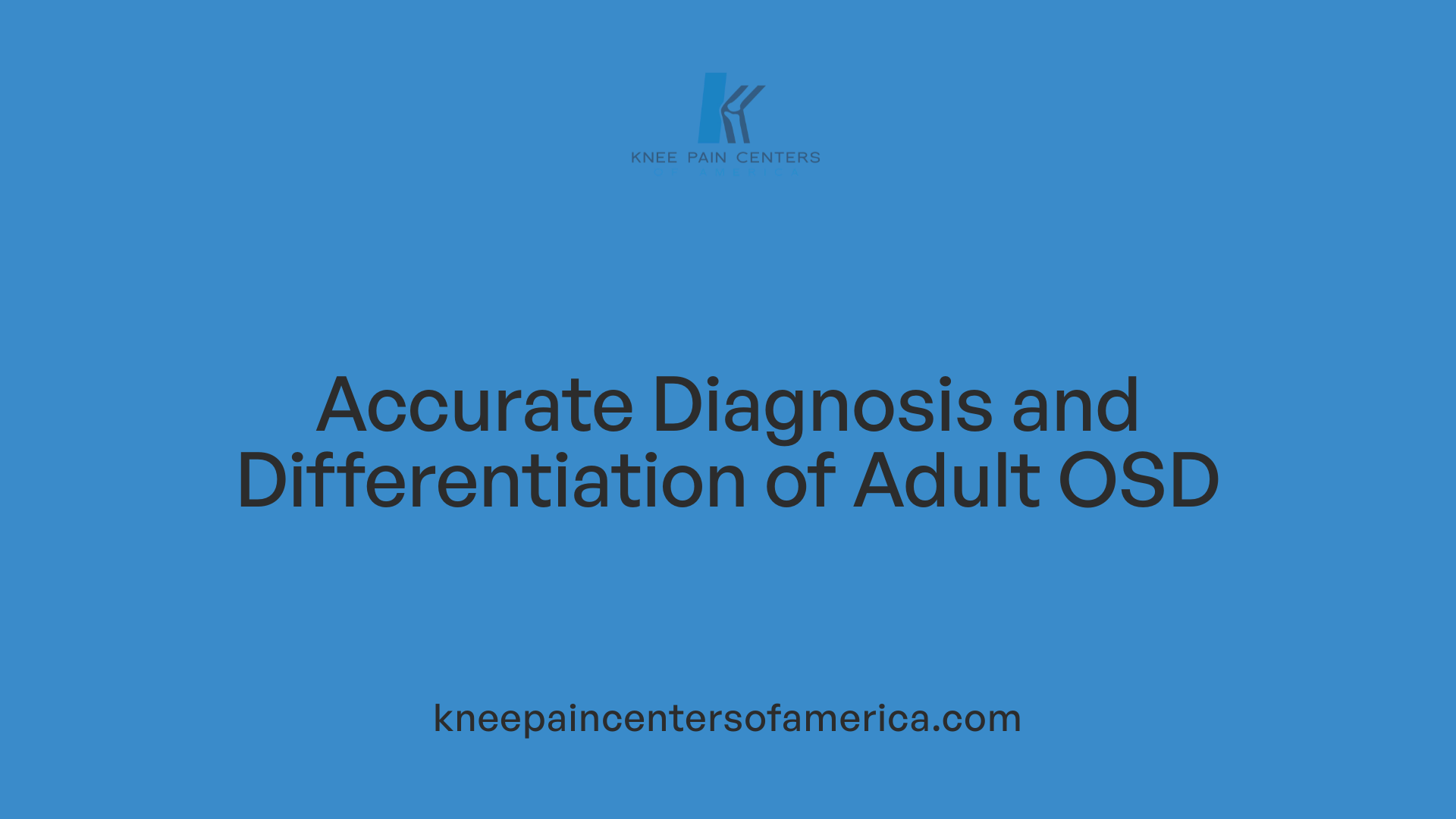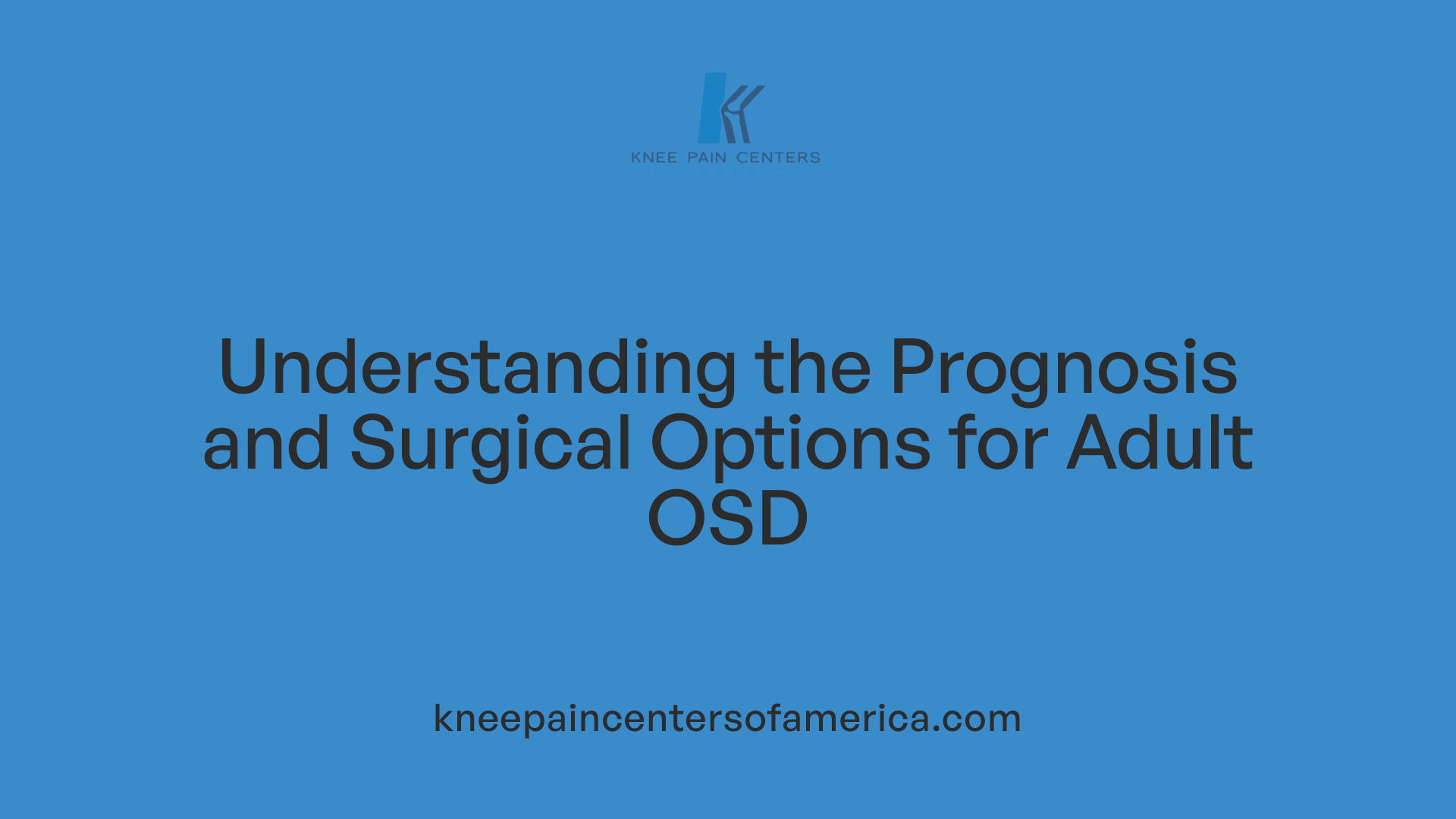Introduction to Adult Osgood-Schlatter Disease
Osgood-Schlatter Disease (OSD) is commonly known as a childhood and adolescent condition affecting active youth, particularly young athletes. However, its presence and implications in adulthood are less recognized but equally significant. This article explores the symptoms, causes, diagnosis, treatments, and management strategies pertinent to adults dealing with OSD, highlighting the importance of accurate diagnosis and tailored intervention in adult cases.
Clinical Presentation and Underlying Causes of Adult OSD

What are the symptoms and causes of Osgood-Schlatter Disease in adults?
Adult Osgood-Schlatter Disease (OSD) typically manifests through a range of symptoms centered around the knee area. Most notably, individuals suffer from persistent localized pain below the kneecap, which often worsens with activity. Swelling and tenderness are common, accompanied by a palpable bony bump or ossicle at the tibial tuberosity—the point where the patellar tendon attaches to the tibia.
In addition to these primary signs, adults may experience stiffness in the knee, muscle weakness, and difficulties performing movements like kneeling or squatting. These symptoms can significantly impact daily functioning and physical activity levels.
The fundamental cause of adult OSD lies in repetitive strain or overuse of the patellar tendon. Activities that involve jumping, running, or frequent kneeling exert high stress on this tendon and its attachment site. Over time, this repetitive stress can lead to irritation, inflammation, and in some cases, the formation of ossicles or bony prominences.
Most adult cases are not new developments but are often residual effects from childhood OSD that was either incompletely treated or never fully resolved. This lingering pathology can be triggered or exacerbated by sustained or increased physical activity. Biomechanical issues, such as misalignment or muscle imbalances around the knee, further contribute to persistent or recurring symptoms.
In essence, adult OSD often results from a combination of previous injury, ongoing mechanical stress, and biological responses to repetitive trauma. Proper diagnosis by a healthcare professional involves physical examination, imaging, and a detailed activity history. Management typically centers on reducing stress on the knee through activity modification, targeted physical therapy, and supportive devices. Surgical intervention remains a last resort, reserved for cases with prominent ossicles that do not respond to conservative methods.
Diagnosis and Differentiation from Other Conditions

How is Osgood-Schlatter Disease diagnosed and treated in adults?
Diagnosing Osgood-Schlatter Disease (OSD) in adults involves a careful clinical examination complemented by imaging studies. Healthcare professionals assess for characteristic signs such as anterior knee pain, tenderness below the kneecap, and a palpable bump over the tibial tuberosity. These signs are typical in both adolescents and adults with persistent or recurrent OSD.
Imaging, especially X-ray analysis, plays a critical role in evaluating bone abnormalities. It helps identify ossified fragments, enlarged tibial tuberosity, or other signs of ongoing or past inflammation. Imaging also assists doctors in differentiating OSD from other similar knee conditions.
In terms of differential diagnosis, OSD should be distinguished from conditions like patella tendonitis, patellofemoral syndrome, stress fractures, and osteochondromas. These conditions can produce similar symptoms but often require different treatment approaches. For example, patella tendonitis involves inflammation of the tendon itself, rather than the bony attachment site.
Persistent symptoms in adults often reflect unresolved issues such as ossified fragments, degenerative joint changes, or other pathologies. Accurate diagnosis ensures targeted management, which may range from conservative care to surgical intervention.
The conservative treatment regimen typically includes rest, ice, compression, elevation, and physical therapy focused on stretching and strengthening leg muscles. Non-steroidal anti-inflammatory drugs (NSAIDs) are also utilized to reduce pain and inflammation.
For adults with significant symptoms resistant to conservative measures, surgical options like bursoscopic or arthroscopic removal of ossified fragments or decompression procedures can be effective. Surgery is generally considered a last resort, especially when symptoms severely impair function or quality of life.
In conclusion, diagnosing and managing OSD in adults require a comprehensive approach that integrates clinical findings and imaging, with treatment plans tailored to individual needs and symptom severity.
Management Strategies and Preventive Measures

What management and prevention strategies are effective for adult Osgood-Schlatter Disease?
Managing adult Osgood-Schlatter Disease involves a multifaceted approach focused on reducing stress on the knee and promoting healing. Conservative treatments are the first line of defense and include activity modifications. Patients are advised to avoid movements that worsen symptoms, such as jumping, running, or kneeling for prolonged periods.
Applying ice to the affected area can help alleviate pain and reduce inflammation. Non-steroidal anti-inflammatory drugs (NSAIDs) are commonly recommended to manage discomfort. Alongside these, physical therapy plays an essential role. Specific stretching exercises targeting the quadriceps and hamstrings can decrease tension on the tibial tuberosity, the site of inflammation and irritation.
Strengthening exercises aimed at the thigh muscles enhance knee stability. Improved muscle support helps distribute stress more evenly during physical activities, lessening strain on the affected growth plate and tendon attachment.
Addressing improper movement patterns through targeted mobility work and biomechanical correction prevents the condition from worsening or recurring. These interventions ensure that gait and movement mechanics do not place unnecessary stress on the knee.
Supportive devices like patellar tendon straps can be used to reduce pain by offloading stress from the attachment site. However, their effectiveness varies among individuals and should be tailored to each patient's needs.
In cases where symptoms persist despite conservative treatment, surgical intervention may be necessary. Surgical options typically involve removing ossified fragments or correcting structural anomalies that contribute to ongoing pain.
Overall, the primary goals are pain relief, functional improvement, and minimizing activity restrictions. Emphasizing rehabilitation through education, mobility correction, and strength training forms the cornerstone of effective management for adults with unresolved Osgood-Schlatter Disease.
This comprehensive approach not only alleviates symptoms but also prevents future episodes, enabling individuals to maintain an active lifestyle with minimal discomfort.
Prognosis, Long-term Outlook, and Surgical Interventions
 Most cases of Osgood-Schlatter Disease (OSD) tend to resolve naturally as individuals reach skeletal maturity, which generally occurs between ages 14 and 18. However, the long-term outlook can vary, especially if the condition was not adequately managed during adolescence. Research indicates that many patients continue to experience residual symptoms into adulthood, including knee pain, swelling, a palpable bony bump, and discomfort, particularly following physical activity.
Most cases of Osgood-Schlatter Disease (OSD) tend to resolve naturally as individuals reach skeletal maturity, which generally occurs between ages 14 and 18. However, the long-term outlook can vary, especially if the condition was not adequately managed during adolescence. Research indicates that many patients continue to experience residual symptoms into adulthood, including knee pain, swelling, a palpable bony bump, and discomfort, particularly following physical activity.
In some cases, adults with unresolved OSD report symptoms that persist for years, with studies showing an average duration of symptoms extending around 7.5 years. These symptoms are often exacerbated by activities that involve jumping, running, kneeling, or sudden movements, reflecting ongoing irritation or impingement at the tibial tuberosity.
Surgical options have shown promising results, especially for adults with persistent or severe symptoms that do not respond to conservative treatments. Procedures such as ossicle excision—removal of bony fragments—and tibial tuberosity reduction have demonstrated high success rates. These interventions are designed to address the bony prominences or ossified fragments that cause pain and mechanical impingement.
The surgical approach involves meticulous visualization of the problematic ossicles, their removal, and repair of the patellar tendon as needed. For example, some techniques incorporate the use of FiberTape sutures and knotless anchors to reattach the tendon securely, which promotes optimal healing and restores knee function.
A recent clinical study involving 35 adult patients who underwent surgery for persistent OSD reported a remarkable 91% of knees experiencing complete resolution of preoperative pain. This outcome underlines the procedure's effectiveness, especially in adults with severe or refractory symptoms who frequently kneel or engage in strenuous activities.
In summary, although most OSD cases resolve with growth and skeletal maturation, a significant subset can suffer ongoing issues. For these individuals, surgical intervention can provide substantial relief and restore knee functionality. Preventive strategies during adolescence, along with attentive management of symptoms, can help minimize long-term complications.
The Role of Surgical Treatment in Adult OSD Cases

When is surgery considered for adult Osgood-Schlatter Disease?
Surgical intervention for Osgood-Schlatter Disease in adults is typically reserved for cases where conservative treatments—such as physical therapy, activity modification, ice, and anti-inflammatory medications—have failed to alleviate symptoms. Particularly, surgery is considered when large, painful ossicles persist and cause significant functional impairment or pain, especially in individuals whose daily activities involve frequent kneeling or exertion.
In adults, unresolved bone fragments or ossicles from childhood OSD can be a source of chronic pain and mechanical impingement. When these bony irregularities do not heal with conservative methods, surgical removal can offer substantial relief.
What are common surgical techniques used?
Surgeons employ different approaches depending on the severity and specific anatomical issues. The most common techniques include:
- Intra-articular debridement: This minimally invasive approach involves arthroscopic inspection and removal of inflamed tissue and ossicles within the joint.
- Open excision of ossicles: For larger or more accessible bony fragments, an open surgical approach allows for direct visualization and removal of ossified tissue.
In cases where impingement is caused by bony overgrowth or deformity at the tibial tubercle, a tibial tuberosity reduction osteotomy may be performed to reshape the bone and relieve pressure.
How is the patellar tendon repaired post-surgery?
Postoperative repairs involve reattaching the patellar tendon securely to facilitate healing and restore knee function. Modern techniques utilize suture anchors and high-strength sutures, like FiberTape, to anchor the tendon back to the tibial tuberosity.
This repair aims to maintain the integrity of the extensor mechanism, prevent recurrent deformity, and promote faster recovery. Proper tendon fixation is crucial for regaining strength and ensuring long-term knee stability.
Outcomes and effectiveness of surgical intervention
Recent studies highlight positive results following surgical treatment for adult OSD. In a review of 35 adult patients undergoing surgery, approximately 91% experienced complete resolution of preoperative pain. Most procedures involved excision of ossified cartilage and bone, with additional procedures like tibial tuberosity reduction to address impingement.
Patients report substantial pain alleviation, improved knee function, and fewer restrictions in daily activities post-surgery.
However, surgery remains a last resort, aimed at patients with persistent symptoms that do not respond to conservative management. The overall prognosis is favorable when appropriate surgical techniques are used.
| Aspect | Details | Additional Notes |
|---|---|---|
| Surgical methods | Arthroscopic debridement, open ossicle excision, tibial tuberosity osteotomy | Tailored to fragment size and location |
| Postoperative repair | Patellar tendon reattachment with suture anchors | Ensures extensor mechanism stability |
| Success rate | 91% report pain relief | Effective for persistent, severe adult OSD |
| Suitable candidates | Adults with large ossicles or impingement | After failed conservative treatments |
Understanding the precise surgical approach and realistic outcome expectations is vital for patients. Surgery can provide significant relief but is typically reserved for severe cases refractory to other treatments.
Summary and Future Directions in Managing Adult OSD
While Osgood-Schlatter Disease is predominantly recognized in children and adolescents, its persistence or de novo occurrence in adults warrants attention. Proper diagnosis, differentiation from other knee conditions, and a personalized management plan emphasizing conservative treatment are essential. Surgical intervention remains a last resort but has shown promising results in alleviating persistent symptoms. As understanding of adult OSD advances, integrating biomechanical assessments, targeted rehabilitation, and appropriate surgical techniques offers the best prospects for restoring knee function and alleviating pain. Continued research and tailored therapeutic strategies will help improve outcomes for adult patients dealing with this condition.
References
- Treatment & Solutions for Knee Pain - Adult Osgood Schlatter Disease
- Osgood-Schlatter Disease | Johns Hopkins Medicine
- Osgood-Schlatter Disease: Ossicle Resection and Patellar Tendon ...
- Osgood-Schlatter Disease: Causes, Symptoms & Treatment
- Podiatric Management of Osgood-Schlatter Disease in Adults
- Results of surgical treatment of unresolved Osgood-Schlatter ...
- Osgood-Schlatter Disease | Johns Hopkins Medicine
- Osgood-Schlatter Disease: Causes, Symptoms & Treatment





